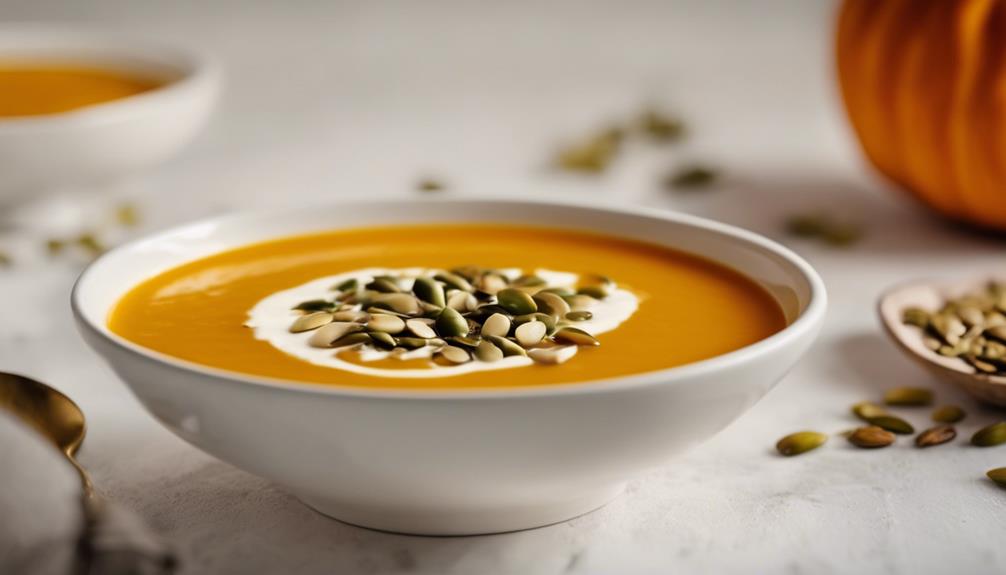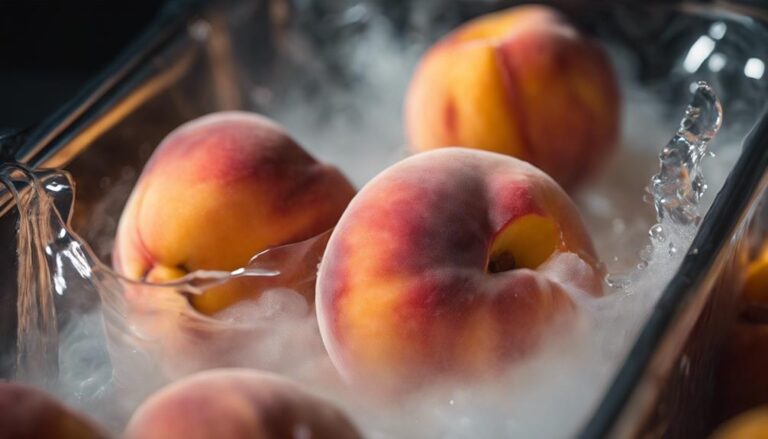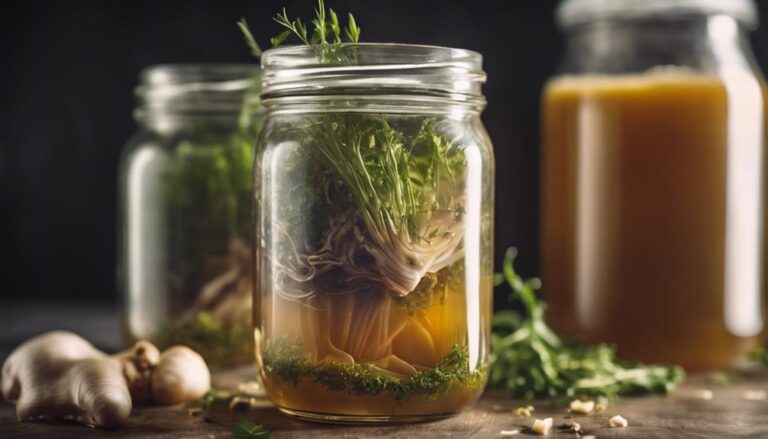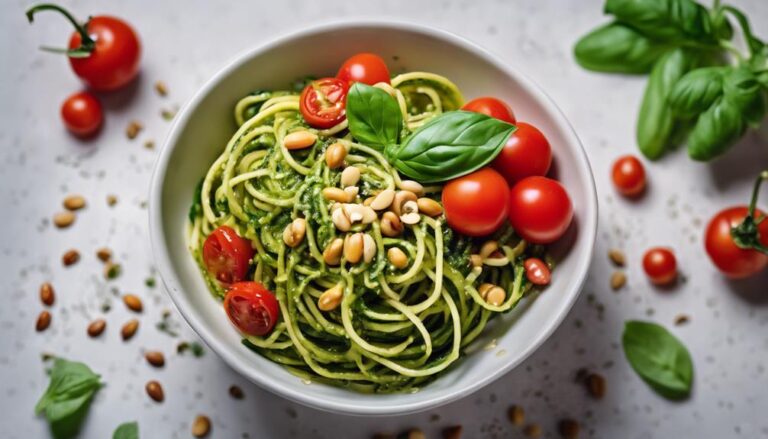Sous Vide Butternut Squash Soup
Immerse in a blend of harmonious flavors and textures with Sous Vide Butternut Squash Soup. Experience the perfect balance of squash's sweetness, apples' tartness, and onions' savory notes. Achieve precise cooking with sous vide technique for flawlessly cooked ingredients. Elevate your soup game by adjusting consistency, seasoning to perfection, and garnishing with diced apples and cinnamon. If you're ready to up your soup-making skills and explore more tips for enhancing flavors and textures, there's a world of culinary delights waiting for you.
What You Will Learn Here
- Sous vide cooking technique ensures precise temperature control for perfectly cooked butternut squash soup.
- Combination of squash, apple, onion, garlic, herbs, and spices creates a harmonious flavor profile.
- Blending cooked ingredients to a smooth consistency enhances the soup's texture.
- Adjusting soup thickness by controlling stock amount for desired consistency.
- Garnishing with diced fresh apple and cinnamon adds both flavor and visual appeal.
Soup's Surprising Medieval Origins
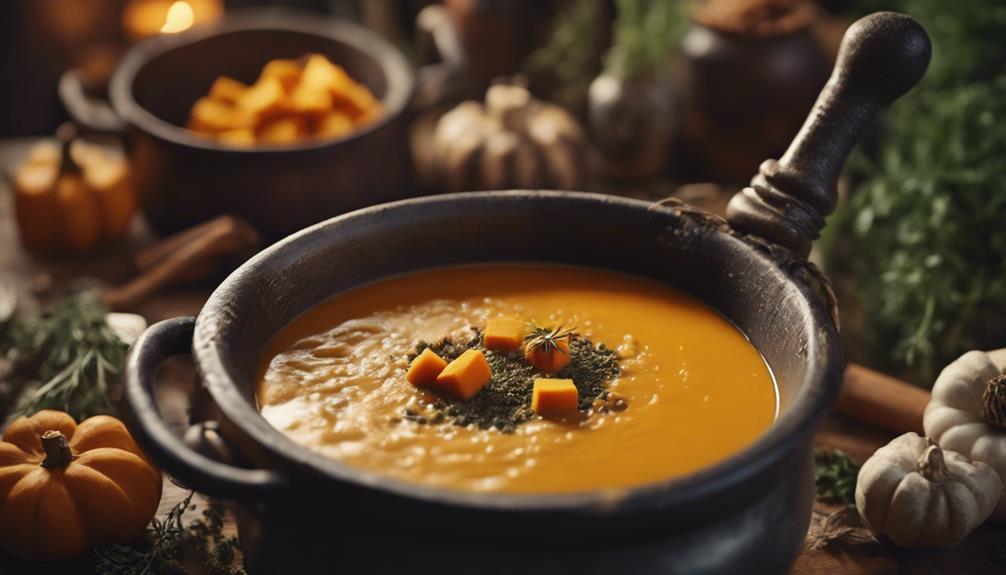
Medieval soups, with their hearty and nourishing qualities, played an essential role in sustaining individuals during challenging periods.
The utilization of simple yet robust ingredients like vegetables and meats in medieval soups influenced the evolution of modern soup recipes.
Exploring the historical context of soups reveals a rich culinary heritage that continues to shape contemporary cooking practices.
Medieval Soup History
The historical roots of soup, tracing back to the Middle Ages, reveal a foundational culinary tradition that continues to influence modern soup recipes.
In medieval times, soups were a staple dish crafted from ingredients like vegetables, grains, and meats, reflecting resource availability. These soups were favored for their ability to feed large groups and provide warmth during cold seasons. Cooked in cauldrons over open fires, the slow cooking process heightened flavors.
This medieval tradition set the stage for the diverse range of soups enjoyed today, including the beloved sous vide butternut squash soup. The evolution of soup from its medieval origins showcases its enduring appeal and adaptability in contemporary culinary practices.
Origins of Soups
Tracing the culinary heritage of soups back to the Middle Ages in Europe reveals their surprising origins rooted in the hearty traditions of that era. In medieval times, soups were a staple food thickened with bread, grains, and at times, blood. Both peasants and nobility enjoyed these hearty dishes.
The term 'soup' originates from the Old French word 'soupe,' referring to bread soaked in broth. Over time, medieval soups evolved to incorporate a range of ingredients, including vegetables and meats, reflecting the diverse culinary landscape. This historical context sheds light on the enduring appeal of soups as comforting and nourishing dishes.
Through innovations like sous vide cooking, modern interpretations such as butternut squash soup continue to honor these medieval roots while offering contemporary twists.
Culinary Heritage Insights
Delving into the historical roots of soup reveals a rich tapestry of culinary traditions spanning medieval Europe. In medieval times, soups were crafted using a variety of ingredients like meat, vegetables, and grains, reflecting the seasonal availability and preservation methods of the era.
The slow cooking process over open fires or in large cauldrons allowed flavors to blend and ingredients to tenderize, resulting in nutritious and easily digestible meals enjoyed by all social classes. The evolution of soup from medieval kitchens to modern cuisine highlights the ingenuity of chefs in adapting new ingredients and techniques.
Fast forward to today, and techniques like sous vide, which involves cooking ingredients in sealed bags in a water bath at precise temperatures, have transformed classic dishes like butternut squash soup into culinary delights that honor the past while embracing innovation.
Key Ingredients for Flavorful Soup
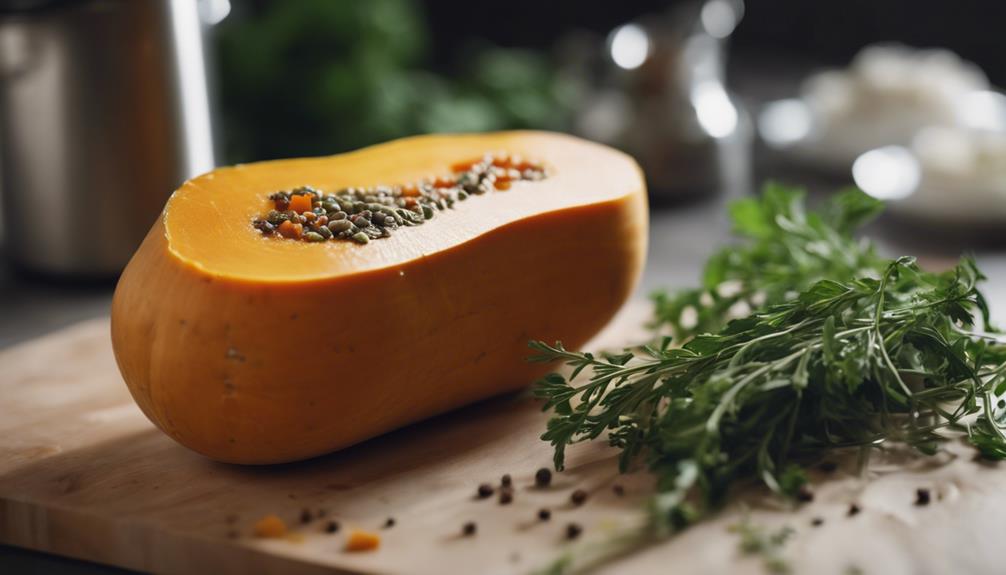
To achieve a flavorful soup, incorporating key ingredients like butternut squash, apples, onions, and fresh herbs is essential. These ingredients work together to create a harmonious blend of flavors that will elevate your soup to a whole new level.
Here are three key ingredients that play an important role in making a delicious butternut squash soup:
- Butternut Squash: As the star ingredient, butternut squash provides a sweet and nutty flavor that's characteristic of this soup. Its smooth texture adds a creamy richness, making each spoonful comforting and satisfying.
- Apples: Adding a hint of natural sweetness and tartness, apples help balance the flavors in the soup. They bring an invigorating element that complements the earthiness of the butternut squash.
- Onions: Onions contribute a savory and aromatic base to the soup, enhancing its depth of flavor. They provide a solid foundation for the other ingredients to shine, creating a well-rounded and savory taste profile.
Tasty Soup Variations
When thinking about tasty soup variations, consider trying a savory squash and apple blend for a sweet and savory combination.
Another option is a buttercup squash and sage blend that offers a rich and earthy flavor profile.
Additionally, a savory pumpkin and coconut soup can provide a creamy and comforting twist to your soup repertoire.
Savory Squash and Apple Blend
In crafting a delightful twist on traditional butternut squash soup, the savory blend of butternut squash and apple emerges as a standout choice for those seeking a rich and flavorful experience. This variation brings a comforting and flavorful soup to the table, known for its rich, sweet, and slightly tangy taste. The combination of these two ingredients adds depth and complexity to the overall flavor profile, with the apple's natural sweetness balancing the earthy notes of the butternut squash. Perfect for fall and winter seasons, this soup variation is cherished for its warm and comforting qualities.
- The blend of butternut squash and apple creates a rich and flavorful soup.
- This variation is characterized by its sweet, tangy, and comforting taste.
- The combination adds depth and complexity to the soup's flavor profile.
Buttercup Squash and Sage Blend
Buttercup squash, renowned for its sweet and nutty essence, pairs harmoniously with the savory earthiness of sage, creating a comforting and aromatic blend in this delightful soup variation.
When preparing this Sous Vide soup, keep in mind the following:
- Flavor Harmony: Buttercup squash's sweetness complements sage's earthy notes, resulting in a well-balanced taste profile.
- Nutritional Benefits: This soup is rich in vitamins A and C, as well as fiber, providing a nutritious meal option.
- Unique Twist: The combination of buttercup squash and sage offers a distinct and delicious twist on traditional butternut squash soup recipes.
Savory Pumpkin and Coconut Soup
Savor the unique blend of savory pumpkin and creamy coconut in this delectable soup variation, elevating your culinary experience with each spoonful.
- Combining the earthy sweetness of pumpkin with the creamy richness of coconut creates a flavor profile that's both comforting and satisfying.
- The addition of warm spices like cinnamon, nutmeg, and curry enhances the overall taste and aroma of the soup, making it a perfect dish for colder days.
- Garnishing with toasted coconut flakes or pumpkin seeds not only adds texture but also visual appeal to this soup, making it a feast for both your taste buds and eyes.
This savory pumpkin and coconut soup is a delightful twist on the classic butternut squash soup, offering a unique blend of flavors that will leave you craving more.
Enhancing Soup Texture Profile
To enhance the texture profile of your butternut squash soup, consider techniques such as:
- Adjusting the thickness by controlling the amount of stock used
- Blending the ingredients to achieve a smooth consistency
Balancing flavors is vital in creating a harmonious texture experience, with options like:
- Adding a creamy almond puree topping to contrast the velvety base
Experimenting with these texture enhancement techniques can elevate your soup to a luxurious and satisfying culinary delight.
Texture Enhancement Techniques
Enhancing the texture profile of butternut squash soup through texture enhancement techniques is essential for achieving a velvety and consistent mouthfeel throughout the dish. When utilizing sous vide cooking for butternut squash soup, the precise temperature control and vacuum-sealed pouch play a vital role in texture enhancement. This method breaks down the fibers in the squash, resulting in a smoother consistency while retaining the flavors and nutrients. By avoiding overcooking or mushiness, the controlled environment of sous vide guarantees a desired velvety texture. The outcome is a luscious and rich soup that maintains a consistent mouthfeel, making each spoonful a delightful experience.
| Texture Enhancement Techniques | Benefits |
|---|---|
| Sous Vide Cooking | Even cooking at precise temperature |
| Vacuum Seal | Retains flavors and nutrients |
| Controlled Environment | Prevents overcooking and maintains desired texture |
Soup Thickness Tips
When refining the texture of your butternut squash soup, mastering soup thickness is a key element to guarantee a satisfying mouthfeel. To achieve the desired consistency, consider adjusting the amount of stock or cream in your soup.
Using a blender or immersion blender will help you create a smooth texture, especially when blending more of the cooked ingredients together for a thicker soup. If needed, you can add a thickening agent like cornstarch or flour to achieve the perfect thickness.
Experiment with different ratios of vegetables to liquid to control the thickness of your soup effectively. By incorporating these soup thickness tips into your sous vide butternut squash soup preparation, you can ensure a velvety and delightful dining experience.
Flavor Balancing Tricks
For a perfect soup texture profile, carefully balance the flavors in your sous vide butternut squash soup to guarantee a harmonious and delightful culinary experience. When enhancing the soup's texture profile, remember to season conservatively in the sous vide bag to avoid overpowering the delicate butternut flavor. Blend the cooked ingredients with stock to achieve a smooth and velvety consistency, adjusting by adding more stock if needed. To elevate the creaminess, incorporate a dollop of almond puree into the soup. Experiment with different toppings for contrasting textures and flavors. Below is a table summarizing key points to help you master the art of flavor balancing in your butternut squash soup:
| Aspect | Recommendation |
|---|---|
| Salt | Season conservatively |
| Stock | Blend for smooth texture |
| Puree | Add almond puree for creaminess |
Final Thoughts
In conclusion, the sous vide butternut squash soup offers a delightful blend of flavors and textures, making it a perfect addition to your autumn menu.
The precise sous vide cooking technique at 185°F for 1 hour guarantees that the ingredients are perfectly cooked and retain their nutrients, resulting in a healthy and comforting option for fall days.
The combination of squash, apple, onion, garlic, herbs, and spices creates a harmonious blend that's both flavorful and aromatic.
The final steps of blending the cooked ingredients, adjusting the consistency, and seasoning to taste are essential in achieving a well-balanced soup.
Garnishing with diced fresh apple and a sprinkle of cinnamon not only enhances the flavor but also adds a visually appealing touch to the dish.
Frequently Asked Questions
Does Butternut Squash Need to Be Peeled for Soup?
You should peel butternut squash for soup to guarantee a smooth texture. Roasting method intensifies flavor and enhances nutritional benefits. Peeling also aligns with most texture preferences, prevents any unpleasant grittiness, and improves the visual appeal. Storage tip: refrigerate leftovers promptly.
Why Is My Butternut Squash Soup Gritty?
If your butternut squash soup has a gritty texture, check your blending method and cooking time. Make sure all ingredients are cooked tender before blending thoroughly to avoid this issue. Quality of ingredients and proper technique are essential.
Is Butternut Squash Soup Good for Blood Pressure?
Butternut squash soup is excellent for blood pressure due to its high potassium and fiber content supporting heart health. Its antioxidants reduce inflammation, benefiting cardiovascular wellness. Enjoy this low-calorie, nutrient-dense option for hypertension prevention.
Is Butternut Squash Soup Healthy?
Yes, butternut squash soup is healthy. Packed with vitamins, fiber, and antioxidants, it supports your well-being. Low in calories, it aids weight management. Easily adaptable to dietary needs, it's gluten-free and nutritious, making it a wise choice for overall health.
Conclusion
To sum up, sous vide butternut squash soup is a delicious and nutritious dish that can be easily prepared with the right ingredients and techniques.
By understanding the origins of soup, utilizing key flavor enhancers, exploring various variations, and mastering texture profiles, you can create a truly satisfying culinary experience.
So, next time you're craving a comforting bowl of soup, consider trying this innovative and flavorful sous vide butternut squash soup recipe.
